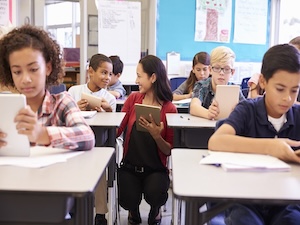Audiobooks are a proven, powerful tool for bridging the gap between general and special education, offering new avenues for collaboration and support for students with learning differences. By providing an alternative means of accessing text, audiobooks revolutionize how educators approach literacy instruction for struggling readers, particularly those with dyslexia.
Enhancing Accessibility and Inclusivity in the Classroom
Traditional text-based materials can be a significant barrier to learning for students with dyslexia and other reading challenges. Audiobooks serve as an essential reading tool, allowing these students to access the same content as their peers. This accessibility promotes inclusivity in the classroom and enables general education teachers to incorporate students with learning differences into their lessons.

Facilitating Collaborative Planning
Audiobooks provide a common ground for general and special education teachers to collaborate on lesson planning. By using audio textbooks as a shared resource, educators can:
– Align curriculum goals
– Develop complementary teaching strategies
– Create inclusive activities that benefit all students
This collaborative approach ensures that students with dyslexia receive consistent support across all their classes.
Supporting Differentiated Instruction
One of the key advantages of audiobooks is their versatility as a tool for reading. They allow teachers to differentiate instruction based on individual student needs:
– Variable playback speeds: Students can adjust the narration speed to match their comprehension level
– Text highlighting: Many audiobook platforms offer synchronized text highlighting, reinforcing the connection between spoken and written words
– Bookmarking and note-taking features: These tools help students with organization and retention
By leveraging these features, general and special education teachers can work together to create personalized learning plans for students with dyslexia.
Enhancing Vocabulary and Comprehension for Struggling Readers
Audiobooks are particularly effective dyslexia reading tools because they allow students to focus on comprehension rather than decoding. This shift in focus has several benefits:
– Improved vocabulary acquisition
– Enhanced understanding of complex concepts
– Increased exposure to grade-level content
General education teachers can use audiobooks to introduce new topics, while special education teachers can reinforce these concepts through targeted interventions.
Fostering Independence and Confidence
For students with dyslexia, reading with traditional methods can be frustrating and demoralizing. Audiobooks offer these students the means to experience literature independently, boosting their confidence and motivation. This newfound independence allows general education teachers to engage struggling readers more fully in class discussions and activities.
The Learning Ally Audiobook Solution® Bridges General and Special Education
The Learning Ally Audiobook Solution® is an invaluable resource for school districts aiming to support students with learning disabilities. By providing access to a vast library of human-narrated audiobooks, including curriculum-aligned titles and popular literature, Learning Ally ensures that students who struggle with reading can engage with the same materials as their peers. This equitable access not only fosters inclusivity but also helps students keep pace with their classmates, enhancing their confidence and participation in classroom discussions.
Learning Ally’s platform is designed to be user-friendly for educators, offering tools that facilitate collaboration between general and special education teachers. With features such as highlighted text synchronization and adjustable playback speeds, educators can tailor the audiobook experience to meet individual student needs. This collaborative approach empowers teachers to implement effective strategies that support struggling readers, ultimately leading to improved academic outcomes for all students.
Audiobooks are more than just a reading tool for students with dyslexia; they are a catalyst for collaboration between general and special education teachers. By providing accessible content, facilitating differentiated instruction, and promoting student independence, audiobooks are helping to create more inclusive and effective learning environments for all students.
Interested in audiobooks for your students? Take a demo meeting and demo with your administrator by October 31st and you will receive free access to our Spotlight on Dyslexia Virtual Conference on-demand! Learn from 50+ experts in the field.
FAQs About Audiobooks in Education
How do human-narrated audiobooks help students with dyslexia?
Human-narrated audiobooks allow students with dyslexia to access content without the challenges of decoding text, enhancing comprehension and engagement. They also provide a multisensory approach to learning, which can improve retention and understanding.
What features should I look for in an audiobook platform?
When selecting an audiobook platform, consider features like adjustable playback speed, synchronized text highlighting, and bookmarking capabilities. These tools enhance the listening experience and support diverse learning needs.
How can teachers collaborate effectively using audiobooks?
Teachers can collaborate by sharing audiobook resources, aligning lesson plans, and developing inclusive activities for general and special education students. This teamwork fosters a unified approach to supporting all learners.
Are there specific audiobooks recommended for struggling readers?
Many audiobooks are tailored for struggling readers, including popular titles that are age-appropriate and engaging. With a reading tool like The Learning Ally Audiobook Solution®, educators can curate lists based on student interests and reading levels to encourage motivation and enjoyment in reading and provide students with the reading titles in their school curriculum.